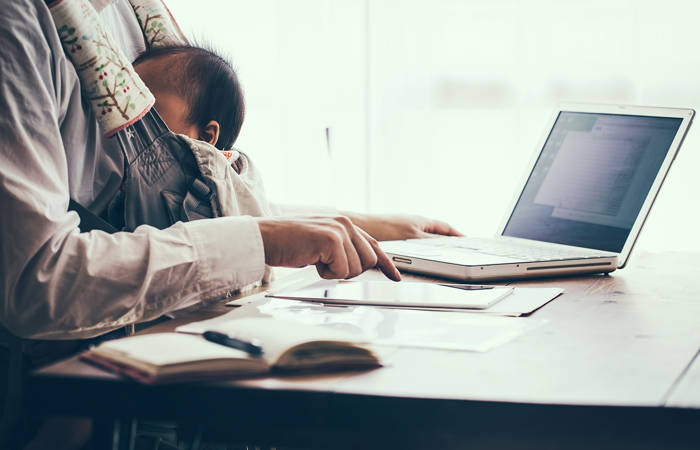Like what you see?
Sign up to receive more free parenting advice.
Thank you for subscribing to our newsletter!
Lifestyle

Credit: iStock.com/Phiromya Intawongpan
Sometimes, it’s called the motherhood penalty. Other times, it’s called the cost of motherhood.
Whatever name you want to give it, it shows the negative economic impact giving birth has on women.
“It’s a concept that summaries the disadvantages that mothers face in the workforce compared to women who don’t have children or even compared to men and fathers,” explains Dr Janin Bredehoeft, Research and Analytics Executive Manager at the WGEA.
“It summarises the gender pay gap when mothers return to work, the discrimination and bias mothers face in recruitment and promotions and the discrimination they face in everyday work life, such as, mothers being perceived as less committed to the job, not physically present at work when they should be or even being too emotional at the office.”
A report released by the Australian Department of Treasury earlier this year found that a mother’s average earnings drop by 55 per cent for, at least, the first five years of the child’s life, often extending into the first ten.
The researchers attributed the sharp decline to lower workforce participation rates post birth.
For mothers who were still engaged in employment after the birth of their first born, their work hours were significantly reduced compared to their pre-birth work hours.
There was also evidence that, for those working mothers, their hourly wage reduced by at least five per cent.
The decline in earnings for mothers was similar regardless of whether they out-earned their partners pre-birth.
Fathers were largely unaffected by the birth of their first child, some even benefiting from their new fatherhood status.
While reduced earnings isn’t unique to Australian mothers, other countries have a much smaller gap between mothers and fathers.
The report highlighted countries like Denmark, with a 25 per cent gap, the UK, with a 36 per cent gap, the US with a 34 per cent gap and finally Sweden with a 40 per cent gap.
Mothers returning to work
Since 2006, Australia has held onto the gold medal for the educational attainment of women and girls.
But, when it comes to women’s workforce participation, we don’t even get a participation ribbon.
In the 2006 Global Gender Gap Report, we placed 12th. In the 2021 report, we placed a dismal 70th.
Why is it, in a country that does such an outstanding job in educating its girls, those very same women don’t return to their careers after the birth of their child?
“The Australian Bureau of Statistics (ABS) reports that the largest barrier for mothers is that they aren’t available to work the hours they want to work after the birth of their child,” Dr Bredehoeft says.
“The biggest contributing factor is either the lack of availability of early childhood education, or the fact that it’s not financially affordable.”
Another contributing factor, one that WGEA finds in its data, is the lack of part-time availability of leadership roles.
“Mothers who have been in leadership roles find they are unable to return to that same level of leadership in a part-time capacity due to the lack of availability,” explains Dr Bredehoeft.
“They might not want to return in a full-time capacity, either because they choose not to, or because of the lack of available and affordable childcare.
“So, they are unable to return to work at the same level they were at before the birth of their child.”
The lack of flexible part-time roles is another huge barrier mothers face.
“Women are three times more likely to work part-time,” she adds.
“But mothers who return to work usually face organisations who don’t offer part-time roles or who don’t offer the full suite of flexible working arrangements which encourage mothers to return to the workforce.”
Dr Bredehoeft explains that organisations need to be creative with their job roles to engage mothers back in the workforce.
One example she gives is instead of offering a part-time role as two full working days a week, offer the same number of hours spread across the week to accommodate school hours.
It summarises the gender pay gap when mothers return to work, the discrimination and bias mothers face in recruitment and promotions and the discrimination they face in everyday work life, such as, mothers being perceived as less committed to the job, not physically present at work when they should be or even being too emotional at the office.Dr Janin Bredehoeft
Stay up to date with the latest news and articles from First Five Years
Thank you for subscribing to our newsletter!
The Dad bonus
While mothers face a penalty, fathers get a bonus when entering parenthood.
“Research shows that when men announce that they will become a father, they are lined up for a promotion and their income will rise,” says Dr Bredehoeft.
She explains that this stems from the societal stereotype that fathers are the family breadwinner and that growing families need additional income which is earned by fathers.
There is also a feeling that fathers are more responsible than their child-free peers and therefore less likely to up and leave a role and more of an investment for the organisation.
“What then happens, is that, while women are at home with the children, fathers continue on this trajectory of promotions,” Dr Bredehoeft adds.
The consequences of keeping mum out of the office
With mothers not returning to the workforce, they are not only missing out on their income, but their superannuation also takes a hit.
“Women in Australia are more likely to face poverty in retirement, which is the compounding effect of the loss of income stay-at-home mothers face,” warns Dr Bredehoeft.
“This is especially significant if relationships break down and women lose the income and retirement savings of their partner.”
Another significant consequence is the generational effect when children see that mothers stay at home to look after the children, while fathers have a career.
“Research has shown that role models, regardless of whether it’s women on boards or women staying home, they have a significant impact on the child’s perspective of family roles,” says Dr Bredehoeft.
“It is important for children, including boys, to see mothers work, or fathers contribute to the child and household responsibilities.
“Both parents need to role model to the future generation that all parents contribute to the economy.”
What needs to change?
On the home front, Dr Bredehoeft recommends that parents challenge their own bias around motherhood and the roles and responsibilities of both parents.
“Discuss the roles you as a family want to role model for your children,” she says.
“Also, discuss what impact it has financially, not only on your family as a whole, but for each individual.”
She emphasises that fathers really need to be a supportive ally to their partners.
Organisations also need to adapt their policies to engage mothers wanting to return to work.
“They need to have gender neutral parenting leave to encourage men to take parental leave,” she recommends.
“They need to offer the full suite of flexible working arrangements to enable mothers to return to work in the capacity that suits them and their family.
“More flexible working arrangements usually results in retainment and mothers increasing their hours as their children age.”
Dr Bredehoeft encourages organisations to be creative in supporting parents, either with financial assistance for early childhood education, or having a childcare centre onsite.
They also need to move away from leadership roles being full-time or physically present – after all, the pandemic has shown that flexible working from home arrangements can be successful.
“Organisations also need to consider offering return to work micro-credentials or workshops to support mothers in skills they may have missed out on while on parental leave,” she says.
“It’s about giving them the confidence to come back to work.”







